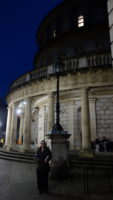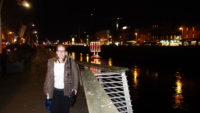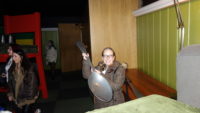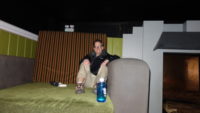 The fellowship of the Dublin trip broke up today, at least for most of the time. Shelby, Regina, and Neuf went off to do a dizzying amount of touring – the Marsh Library, St. Patrick’s Cathedral, the Little Museum of Dublin, the EPIC Emigration Museum, and a 90-minute bus tour of all of Dublin. I think they were using different clocks than we were.
The fellowship of the Dublin trip broke up today, at least for most of the time. Shelby, Regina, and Neuf went off to do a dizzying amount of touring – the Marsh Library, St. Patrick’s Cathedral, the Little Museum of Dublin, the EPIC Emigration Museum, and a 90-minute bus tour of all of Dublin. I think they were using different clocks than we were.
Meredith and I got a late start, setting off around 10:00 to go to sites we had not seen before. We started at the General Post Office (the GPO), which is still a working post office, but was the main headquarters for the Easter Uprising of 1916. There is a museum on site now that only opened in 2016, so we wanted to check it out.
It was an excellent little museum. It framed the history that led up to 1916, with Home Rule a very real and near possibility for Ireland. Home Rule would have kept Ireland as part of the United Kingdom, but returned some powers back to the Irish, including an Irish parliament. Home Rule was almost a done deal when World War I broke out, which tabled the issue in light of the war. If the war hadn’t broken out, would Home Rule have passed, and if that had happened, would there have been an uprising? Interesting, if unanswerable, questions.
There were pro-union Irish who didn’t want Home Rule – they saw themselves as British and opposed the movement, even with some going so far as to create an armed group in Belfast. In response, pro-nationalist Irish armed themselves in Dublin, which created the armed group that rebelled Easter week. If the unionists hadn’t armed, would there have been a rebellion?
 The nationalists were being supplied weapons by the Germans, and a shipment of twenty thousand rifles was intercepted by the British as it came into an Irish bay. If that had gotten through, would there have been more Irish troops in Dublin that week (instead, there were about fifteen hundred Irish versus twenty thousand British by the end of the week)?
The nationalists were being supplied weapons by the Germans, and a shipment of twenty thousand rifles was intercepted by the British as it came into an Irish bay. If that had gotten through, would there have been more Irish troops in Dublin that week (instead, there were about fifteen hundred Irish versus twenty thousand British by the end of the week)?
The museum walked through each day of the uprising in an excellent film. Mer mentioned how strongly it reminded her of Les Miserables – the rebels kept hoping for a popular uprising. It was quite the opposite at first – the local Dubliners were irritated at the disruption. But, as the rebels held out against overwhelming odds for days, the mood began to change. The public swung over to the nationalist side when the British tried the leaders secretly and then executed them over the course of over a week. As information leaked out, outrage began to build, which allowed the nationalist party to get voted in during the next election. They set up their seats in Dublin instead of in London, which didn’t go over well in England, which didn’t help the mood in Ireland.
Eventually, a guerilla war broke out for two years, which ended with the English and Irish signing a treaty that broke off six counties in the north to remain in the UK, and the rest of Ireland would have local power, but still swear allegiance to the king. This compromise split the Irish, and a civil war broke out a few months later that lasted a year. The more radical nationalists lost the shooting war, but were eventually elected into power, which helped bring about the Republic of Ireland in the 1940s.
 As you can see, the museum covered a lot. The recommended time to cover the material was forty-five minutes. It took us over two hours, and we skipped some things. We do love a good museum.
As you can see, the museum covered a lot. The recommended time to cover the material was forty-five minutes. It took us over two hours, and we skipped some things. We do love a good museum.
On the way to get some light lunch, we passed a free exhibit on the Irish poet Seamus Heaney. So, after lunch, we went back to it. It was one of those delightful surprises we run into when we travel. The exhibit had many original pieces that Heaney had donated to the national library, so we got to see some of his edits on earlier drafts. Many poems were reprinted or read out loud, and many of the phrases Heaney came up with were gorgeous. He often focused on ordinary things, people, or work, but expressed them in eloquent poetry that sometimes choked me up. Mer tried to tell me of one of her favorites that reminder her of her mom, and she couldn’t even recite it for the tears it brought. The man had a way with words. We stayed there for an hour, until they closed at 4:00.
 That didn’t leave us a ton of time before most tourist things closed at 5:00, but the National Museum of Archaeology is free, so we went there for thirty minutes. I got to see the bog men, who were people who were killed and thrown into bogs. Their bodies (and sometimes hair and clothing) were preserved. It was timely because we had read about how the bog men moved Heaney to write poems about them that compared what was done to them to what was going on in Northern Ireland at the time. We also got to see a small gold boat about which Heaney had written – we stumbled across it without even knowing it would be in the museum. We saw the Brooch of Tara – Mer went to look up where it was when she realized we were standing in front of it. We also got to see a few hoards of gold that had been found in bogs over the years. It was an efficient use of thirty minutes.
That didn’t leave us a ton of time before most tourist things closed at 5:00, but the National Museum of Archaeology is free, so we went there for thirty minutes. I got to see the bog men, who were people who were killed and thrown into bogs. Their bodies (and sometimes hair and clothing) were preserved. It was timely because we had read about how the bog men moved Heaney to write poems about them that compared what was done to them to what was going on in Northern Ireland at the time. We also got to see a small gold boat about which Heaney had written – we stumbled across it without even knowing it would be in the museum. We saw the Brooch of Tara – Mer went to look up where it was when she realized we were standing in front of it. We also got to see a few hoards of gold that had been found in bogs over the years. It was an efficient use of thirty minutes.
 We ate supper in the Temple Bar neighborhood, and then walked north of the Liffey to go to the National Leprechaun Museum for an evening of dark storytelling. We met up with the others there, so our little fellowship was reunited. The museum was a ton of fun – Mer and I had thought it would just be a matter of showing up to hear stories, but we kept moving from room to room, passing through a giant’s room (where we jumped on the furniture), and going through a forest and a mirror maze and a glen. At each stop, we heard stories about changeling children and brutal kings and leaders fighting, all told by a witty Irishman from the southwest of Ireland, who also had a grand singing voice. It was a fantastically good time, and a good note on which to end our trip.
We ate supper in the Temple Bar neighborhood, and then walked north of the Liffey to go to the National Leprechaun Museum for an evening of dark storytelling. We met up with the others there, so our little fellowship was reunited. The museum was a ton of fun – Mer and I had thought it would just be a matter of showing up to hear stories, but we kept moving from room to room, passing through a giant’s room (where we jumped on the furniture), and going through a forest and a mirror maze and a glen. At each stop, we heard stories about changeling children and brutal kings and leaders fighting, all told by a witty Irishman from the southwest of Ireland, who also had a grand singing voice. It was a fantastically good time, and a good note on which to end our trip.
Mer and I went back to the hotel to look up itineraries while Neuf and Regina and Shelby went to eat supper. One way to squeeze in half a dozen tourist sights is to skip supper. It was a fantastic trip, with surprisingly good weather over the week – we only got rained on twice, for a total of about twenty minutes. What wasn’t surprising was the good fellowship. We had a good group with which to roam about the old sod.